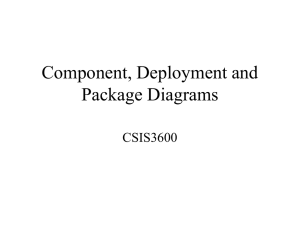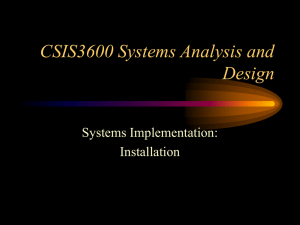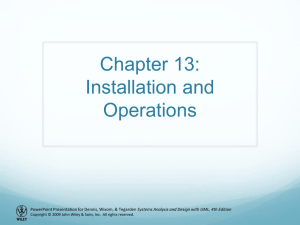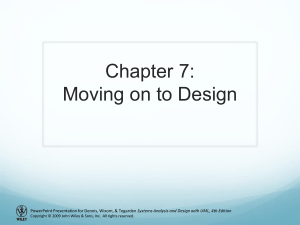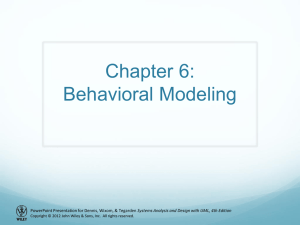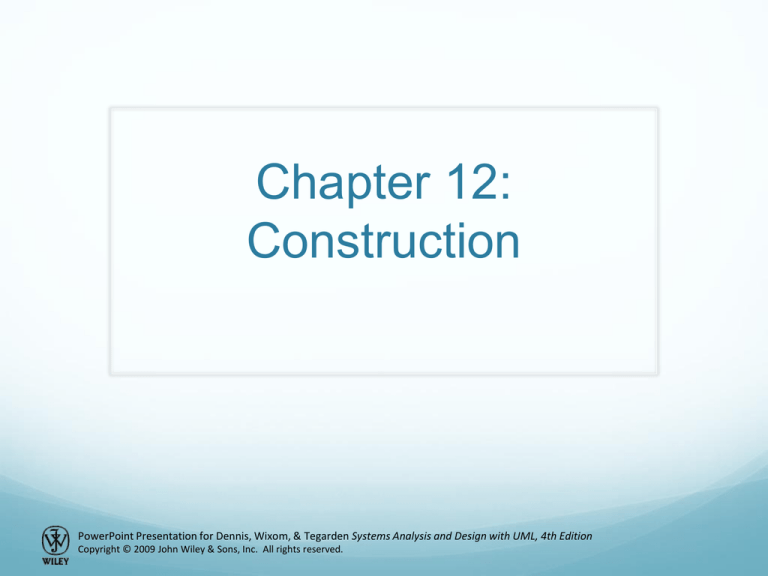
Chapter 12:
Construction
PowerPoint Presentation for Dennis, Wixom, & Tegarden Systems Analysis and Design with UML, 4th Edition
Copyright © 2009 John Wiley & Sons, Inc. All rights reserved.
Objectives
Be familiar with the system construction process.
Understand different types of tests and when to use
them.
Understand how to develop documentation.
PowerPoint Presentation for Dennis, Wixom, & Tegarden Systems Analysis and Design with UML, 4th Edition
Copyright © 2009 John Wiley & Sons, Inc. All rights reserved.
Introduction
Construction is the development of all parts of the
system:
The software itself
All documentation and new operating procedures
Includes implementation, testing and configuration & change
management work flows
Programming is the largest, but least risky part of
systems development
Project failure is not usually due to poor programming but to
poor analysis, design, installation or project management
Most organizations devote more time to testing &
evaluation than to programming.
PowerPoint Presentation for Dennis, Wixom, & Tegarden Systems Analysis and Design with UML, 4th Edition
Copyright © 2009 John Wiley & Sons, Inc. All rights reserved.
Managing Programming
Project managers must:
Assign programming tasks
Group related classes to minimize coupling & maximize cohesion of
modules
Assign the classes to programmers
Coordinate activities
Manage the schedule
PowerPoint Presentation for Dennis, Wixom, & Tegarden Systems Analysis and Design with UML, 4th Edition
Copyright © 2009 John Wiley & Sons, Inc. All rights reserved.
Coordinating Activities
Hold weekly project meetings
Create and enforce standards
Divide resources into three areas:
Development
Testing
Production
Implement change control measures
PowerPoint Presentation for Dennis, Wixom, & Tegarden Systems Analysis and Design with UML, 4th Edition
Copyright © 2009 John Wiley & Sons, Inc. All rights reserved.
Managing the Schedule
Time estimates must be revised as construction proceeds
Build a 10% error margin into all schedules
Common cause for schedule problems is scope creep
Occurs when new requirements are added to the project after the
system design was finalized
Changes become more expensive when added later in the project
schedule
Small slippages in the schedule can add up to large
schedule problems
Risk assessments can help predict problems
Evaluate their likelihood
Evaluate their impact
PowerPoint Presentation for Dennis, Wixom, & Tegarden Systems Analysis and Design with UML, 4th Edition
Copyright © 2009 John Wiley & Sons, Inc. All rights reserved.
Cultural Issues
Offshore outsourcing introduces potential cultural conflicts
Context may influence a person’s ability to see potential
solutions
Individualism vs. collectivism may determine how people
work together and how they view intellectual property
Monochronic vs. polychronic determines how people view
deadlines
Other issues:
Power distance
Uncertainty avoidance
Masculinity vs. femininity
Long term vs. short term orientation
PowerPoint Presentation for Dennis, Wixom, & Tegarden Systems Analysis and Design with UML, 4th Edition
Copyright © 2009 John Wiley & Sons, Inc. All rights reserved.
Designing Tests
The purpose of testing is to uncover as many errors as
feasible
It is impossible to prove that the system is error free
It is too expensive to look for all possible bugs
Four stages of testing
Unit tests
Integration tests
System tests
Acceptance tests
PowerPoint Presentation for Dennis, Wixom, & Tegarden Systems Analysis and Design with UML, 4th Edition
Copyright © 2009 John Wiley & Sons, Inc. All rights reserved.
Testing and Object Orientation
Encapsulation and Information-Hiding
Polymorphism and Dynamic-Binding
Inheritance
Reuse
Object-Oriented Development Process and Products
PowerPoint Presentation for Dennis, Wixom, & Tegarden Systems Analysis and Design with UML, 4th Edition
Copyright © 2009 John Wiley & Sons, Inc. All rights reserved.
Test Planning
A test plan define a series of tests to be conducted
Testing takes place throughout the development of an
object-oriented system
Develop the test plan at the beginning and modify it as the
system evolves
Each test has a specific objective and describes a set
of specific test cases
Test specifications are created for each type of constraint that
must be met by a class
Stubs are hard-coded placeholders that allow testing using
unfinished classes
PowerPoint Presentation for Dennis, Wixom, & Tegarden Systems Analysis and Design with UML, 4th Edition
Copyright © 2009 John Wiley & Sons, Inc. All rights reserved.
Unit Tests
Unit tests focus on a single class
Black box testing
Examines externally visible behaviors of a class
Driven by CRC cards, behavior state machines and method
contracts, not by tester’s interpretation
Each item in the spec becomes a test
White box testing
Examines the internals of a class
Driven by method specifications for the class
Small method sizes limits the usefulness of this type of testing
Behavioral state machines can identify tests for a class
PowerPoint Presentation for Dennis, Wixom, & Tegarden Systems Analysis and Design with UML, 4th Edition
Copyright © 2009 John Wiley & Sons, Inc. All rights reserved.
Integration Tests
Assess whether a set of classes that must work
together do so without error
Four common approaches
User interface testing
Use case testing
Interaction testing
System interface testing
Most projects use all four approaches
PowerPoint Presentation for Dennis, Wixom, & Tegarden Systems Analysis and Design with UML, 4th Edition
Copyright © 2009 John Wiley & Sons, Inc. All rights reserved.
System Tests
Conducted to ensure all classes work together without
error
Similar to integration testing but broader in scope
How well does the system meet the business requirements
Also tests the system’s documentation
PowerPoint Presentation for Dennis, Wixom, & Tegarden Systems Analysis and Design with UML, 4th Edition
Copyright © 2009 John Wiley & Sons, Inc. All rights reserved.
Acceptance Tests
Performed primarily by users with support of the project
team
Goal is to confirm that the system meets the business
needs and is acceptable to the users
Alpha testing—data is artificial
Beta testing—data is real but carefully monitored for
errors
PowerPoint Presentation for Dennis, Wixom, & Tegarden Systems Analysis and Design with UML, 4th Edition
Copyright © 2009 John Wiley & Sons, Inc. All rights reserved.
Developing Documentation
Documentation of the system must be done throughout
system development
Two fundamentally different types
System documentation
Assists programmers and analysts build or maintain the system
Created as the project unfolds
User documentation
Assists users to operate the system
Most users will not read the manuals before starting to use the system
Online documentation makes searching simpler
Developing & testing documentation takes time
PowerPoint Presentation for Dennis, Wixom, & Tegarden Systems Analysis and Design with UML, 4th Edition
Copyright © 2009 John Wiley & Sons, Inc. All rights reserved.
Types of Documentation
Reference Documents
Tell users how to perform specific tasks
Procedure Manuals
Describe how to perform business tasks
Each procedure normally entails multiple tasks
Tutorials
Teach people how to use specific components of a system
PowerPoint Presentation for Dennis, Wixom, & Tegarden Systems Analysis and Design with UML, 4th Edition
Copyright © 2009 John Wiley & Sons, Inc. All rights reserved.
Designing Documentation Structure
Online documentation will likely become the standard
Develop a set of documentation navigation controls that
lead the user to documentation topics
Topics generally come from 3 sources
Commands and menus in the user interface
How to perform certain tasks, which can be found in:
Use scenarios
WNDs
Real use-cases
Definitions of important terms
PowerPoint Presentation for Dennis, Wixom, & Tegarden Systems Analysis and Design with UML, 4th Edition
Copyright © 2009 John Wiley & Sons, Inc. All rights reserved.
Writing Documentation Topics
Start with clear titles
Include introductory text
Finish with detailed, step-by-step instructions
Consider using screen images
Video tutorials are very helpful (e.g., record the
desktop while performing a task)
Follow established guidelines (fig. 12-10)
PowerPoint Presentation for Dennis, Wixom, & Tegarden Systems Analysis and Design with UML, 4th Edition
Copyright © 2009 John Wiley & Sons, Inc. All rights reserved.
Identifying Navigation Terms
Table of Contents is developed from the logical
structure of the documentation topics
Sources for items for the index and search engine
Set of commands in the user interface (e.g., File ► Open)
Major concepts of the system (often use-cases and classes)
The set of business tasks to be performed (e.g., order
placement)
Synonyms of the preceding items (users’ vocabularies may not
be precise)
PowerPoint Presentation for Dennis, Wixom, & Tegarden Systems Analysis and Design with UML, 4th Edition
Copyright © 2009 John Wiley & Sons, Inc. All rights reserved.
Summary
Managing Programming
Designing Tests
Developing Documentation
PowerPoint Presentation for Dennis, Wixom, & Tegarden Systems Analysis and Design with UML, 4th Edition
Copyright © 2009 John Wiley & Sons, Inc. All rights reserved.

